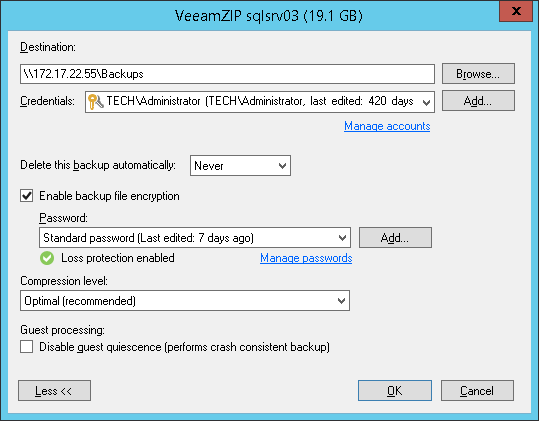You can quickly back up running and powered off VMs with VeeamZIP. Creating a VeeamZIP file can be helpful if you want create an ad-hoc backup for VMs, archive VMs before decommissioning and so on.
Prior to performing creating a VeeamZIP file of a VMware VM, check the following prerequisites:
- Make sure that the source host is added to the backup infrastructure.
- Make sure that there is enough space on the backup destination.
|
In Veeam Backup Free Edition, you can run a VeeamZIP job for one VM only. If you have a valid trial or full license installed, you can run a VeeamZIP job for a number of VMs at a time. |
To create a VeeamZIP file, follow the next steps:
- Open the Virtual Machines view.
- In the infrastructure tree, click the Hyper-V host or VM container in which the necessary resides.
- In the working area, select the necessary VM and click VeeamZIP on the ribbon or right-click the necessary VM and select VeeamZIP.
To quickly find the necessary VM, type the VM name or a part of it in the search field at the top of the working area and click the Start search button on the right or press [ENTER].
- In the Destination section, specify a location in which you want to store the VeeamZIP file.
- To store the VeeamZIP file in a local folder on the Veeam backup server, select Local or shared folder, click Browse on the right and select a folder in which the VeeamZIP file must be stored.
- To store a VeeamZIP file in a shared folder, select Local or shared folder and type in the UNC name of the shared folder in the field below. Keep in mind that the UNC name always starts with two back slashes (\\).
If the shared folder requires authentication, select the necessary credentials from the Credentials list. If you have not set up credentials beforehand, click the Manage accounts link or click Add on the right to add necessary credentials. For more information, see Managing Credentials.
- Use the Delete this backup automatically list to specify retention settings for the created VeeamZIP file. By default, VeeamZIP files are not removed and kept in the specified location for an indefinite period of time.
- To encrypt the created VeeamZIP file, select the Enable backup file encryption check box. From the Password list, select a password that you want to use to encrypt the VeeamZIP file. If you have not created a password beforehand, click Add or use the Manage passwords link to specify a new password. For more information, see Managing Passwords for Data Encryption.
- From the Compression level list, select a compression level for the created backup: None, Dedupe-friendly, Optimal, High or Extreme.
- By default, Veeam Backup Free Edition uses native Hyper-V quiescing mechanisms to create a transactionally consistent image of VMs. You can optionally disable VM quiescence. To do this, select the Disable guest quiescence check box. In this case, Veeam Backup Free Edition will create a crash-consistent VM backup.
- Click OK. The VeeamZIP task will start immediately. Veeam Backup Free Edition will create a full backup file (VBK) and store it in the specified location. The VM name, date and time of the file creation are appended to the file name so you can easily find the necessary VeeamZIP file afterwards.
- As the job runs, you can track the job performance in the real-time mode. To see the job results once it completes, open the History view, expand the Jobs node and click Backup. Then double-click the job session in the list.
|
Veeam Backup Free Edition keeps the settings of the latest VeeamZIP job. To quickly start a VeeamZIP job with the settings of the previous job, right-click the necessary VM and select VeeamZIP to from the shortcut menu. The VeeamZIP job will start immediately. The created VeeamZIP file will be stored to the same location as the previously created VeeamZIP file. |








